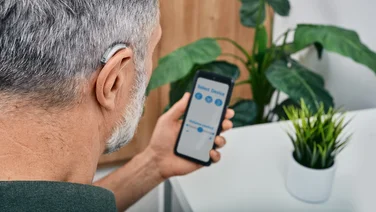To help us provide you with free impartial advice, we may earn a commission if you buy through links on our site. Learn more
- Get a free hearing aid quote today
- How do hearing aids work? Everything you need to know
- How do hearing aids work to enhance sound?
- How do hearing aids work for tinnitus?
- How do different types of hearing aid work?
- What extra features do hearing aids have?
- Do hearing aids work for deaf people?
- How do hearing tests work?

Hearing aids have come a long way since the days of clunky transistors that made everything louder. Today’s discreet digital hearing aids work by improving the quality of sound, rather than simply hoicking up its volume. Speech is easier to hear, while distracting background noise is blocked to suit your preferences, and hearing aid batteries are better than ever. The results are life-changing for millions of people.
But according to UK organisations including the RNID (Royal National Institute for Deaf People) and Hearing Link, far more people should be benefiting from hearing aids. While 59% of UK people wear glasses, only just over 3% use hearing aids. According to the RNID, one in five UK adults (12 million) currently suffer from hearing loss, and the figure is rising. That’s a lot of people whose social lives, working lives, health and happiness could be transformed by wearing these ever-more sophisticated devices.
In this article, we’ll reveal how today’s tiny digital hearing aids work to enhance the sensory and communication experience of their wearers, whether they’re suffering from mild deafness, severe hearing loss or even tinnitus.
If you have an idea of your hearing aid requirements, you can use our free quote finder tool to find a local hearing specialist.
Get a free hearing aid quote today
If you’d like to know how much hearing aids could cost you, fill in our quick survey below – we’ll provide you with a quote that matches your exact requirements.
How do hearing aids work? Everything you need to know
How do hearing aids work to enhance sound?
Ever since 18th-century gents hit upon the power of ear trumpets, hearing aids have evolved in line with audio technology. When the telephone was invented, the first electronic hearing aid followed soon after. When the transistor came along in the 1950s, it paved the way for small, wearable hearing aids (and their infamous feedback whistle).
The next big audio breakthrough was, of course, digital. This has enabled scientists to create hearing aids that are essentially tiny computers. There are a few different types, but these are distinguished mainly by their shape and size. All modern digital hearing aids contain the same five basic components:
- Microphone
- Processor
- Amplifier
- Speaker
- Battery
The processor is what makes today’s digital hearing aid more than just an amplifier. It selects sounds in an intelligent way, according to your type of hearing loss, and then it analyses and adjusts them appropriately before sending them to the amplifier.
The amplifier transmits the adjusted sounds into your inner ear via the speaker, plus tubing and/or a thin wire. In the inner ear, sounds are transformed into electrical impulses which are picked up by your brain, where they are processed and interpreted. All of this happens so quickly as to appear instantaneous.
READ NEXT: How much do hearing aids cost?
How do hearing aids work for tinnitus?
You may worry that any amplification of sound would make tinnitus worse, but the opposite is usually the case. This is partly because amplified and clarified external sounds can help to distract you from the internal noise of tinnitus. According to Tinnitus UK, hearing aids also replace perceived sound (tinnitus) with “heard sound”, which you can customise and adjust to suit you.
Looking to find out how much hearing aids could cost you?
Find the best provider for you
How do different types of hearing aid work?
The right type of hearing aid for you will depend on a host of factors including your type of hearing loss, your dexterity (very small hearing aids can be quite fiddly), and also the size of your ear canal. They all work using the process outlined above, but the position of your hearing aid on or in your ear can make quite a difference to their effectiveness and comfort. Here’s a quick overview.
1. In-the-ear (ITE) hearing aids
These small, discreet hearing aids have a closed design that means they work by transmitting sound to you directly. Their dinky size and in-ear position mean it’s easy to wear headphones and use the phone while wearing them, but they’re less powerful than larger models, so they’re not the best option for severe hearing loss. And if your ear canal is small or narrow, ITE hearing aids may be too large to fit inside them.
You can also get in-the-canal (ITC hearing aids, which are basically ITE but moulded to fit your ear canal perfectly. They’re slightly larger than ITE hearing aids, so they may be easier to handle if your fingers aren’t as nimble as they used to be.
ITE hearing aids, such as the Signia Silk 5Nx Digital Hearing Aid (currently £898/pair from Hearing Direct), don’t usually need to be fitted by an audiologist.

2. Behind-the-ear (BTE) hearing aids
These are larger but more powerful than ITE hearing aids, so they’re ideal for people with more severe hearing loss. They sit behind your ear and work by transmitting sound via a receiver that sits either in the ear or the ear canal, plus a tube or wire in the canal. These hearing aids often have more functions such as Bluetooth connectivity and rechargeable batteries.
These hearing aids, such as the Styletto 1X Rechargeable (currently £899/pair from Hearing Direct) are best fitted by an audiologist, who will help you find the perfect model and size for you.
What extra features do hearing aids have?
Extra features can really make a difference to the quality of sound your hearing aids capture, and the convenience they bring. If you’re eager to get the most natural hearing experience possible, then look out for features such as noise management, extended bandwidths, automatic volume regulation, and different conversation environment presets. Tinnitus masking and anti-shock, which instantly suppresses sudden loud sounds, are included with many larger BTE (behind-the-ear) hearing aids.
There are plenty of features that add to the convenience of using hearing aids, too. The ability to connect your hearing aids to your mobile phone via Bluetooth is now included with most mid- to high-end hearing aids, as well as the ability to stream music and control your TV and smart speaker via voice control. Most hearing aids have an accompanying app, and some have a handheld remote control.
Binaural phone streaming is a great feature for phone users since it automatically streams audio from your phone to your hearing aids. Health data tracking and waterproofing are also worth looking out for.
Rechargeable batteries don’t come as standard with all hearing aids. If you want rechargeables, look for feature-rich BTE hearing aids such as the Unitron Moxi Blue 3 (currently £1,750/pair from Hearing Direct).
For more hearing aid prices and features, see our in-depth article: How much do hearing aids cost?
Do hearing aids work for deaf people?
Hearing aids only help if you still have some hearing left. If you are profoundly deaf, meaning you suffer from hearing loss of more than 90 dBHL (decibel hearing loss), most hearing aids won’t be powerful enough to help you hear more clearly, and if you are completely deaf they won’t restore your ability to hear. The onset of hearing loss is nearly always gradual, so the earlier you start wearing a hearing aid, the greater the benefit you’re likely to get from it.
ITE and ITC hearing aids are most effective if you suffer from mild to moderate hearing loss, which is greater than 25 dBHL. That currently accounts for one in five UK adults, according to the RNID. They estimate that a further 1.2 million UK people currently have hearing loss greater than 65 dBHL, classed as severe (“speech has to be louder than normal, group conversations are difficult”). BTE hearing aids can help people with moderate to severe hearing loss.
It’s important to note that hearing aids are “not like putting on a pair of glasses” (my dad, 82, was very clear on this). They don’t magically restore the hearing you had as a 17-year-old. Indeed, the NHS says “hearing aids will not make your hearing perfect.” What they will do is make sounds much clearer, and reduce the impact hearing loss has on your life.
Looking to find out how much hearing aids could cost you?
Find the best provider for you
How do hearing tests work?
Hearing tests check your ability to hear sounds of different pitches and loudness. The results are charted on a graph called an audiogram, which helps to measure the severity of your hearing loss and the type of hearing aid that can help.
Free hearing tests are available on the NHS via your GP, but it may take some time to be referred to a specialist. If you want immediate quotes for a specialist hearing appointment, visit our sister site HearClear and take their quick survey.






